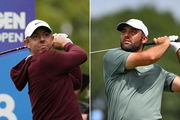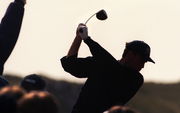

The gentleman’s sport can be harsh at times, especially with respect to small joints like the ankles. However, some of the most commonly injured body parts are the knees, given the repeated, grueling strain that knees encounter. We all know knees help generate power and enhance the efficiency of the swings, acting as shock absorbers. Undoubtedly, the uneven weight distribution on the knees and the constant rotational stress build up over time and result in injuries like torn ligaments. Hence, for the longevity of your golfing years, it’s essential to learn how to prevent these injuries.
Watch What’s Trending Now!
Let’s take a look at 5 common knee injuries and understand how you can prevent them.
Top Stories
Cheating Allegations Erupt as Scottie Scheffler Narrowly Beats Rory McIlroy at Golf Channel Games

Rory McIlroy’s Disastrous Shot Hits Shane Lowry at Golf Channel Games

PGA Tour Event at Risk of Cancellation as $4.7 Billion Sponsor Ends Decade-Long Partnership

Concerns Arise as Amanda Balionis Says She’s Exhausted After Demanding Golf Schedule

Scottie Scheffler Makes Critical Health Announcement After He Ended PGA Tour Hiatus

ADVERTISEMENT
#1: ACL Injury
Joining the femur (thigh bone) to the tibia (shin bone), the ACL stabilizes the knee. However, that also puts it at higher risk of strain. The rotational forces of the swing can twist the ACL. As the weight shifts from the back leg to the front during the swing, the rear leg bends inwards, helping the torso rotate towards the shot. Improper swing mechanics can tear these ligaments. Knee instability and swollen kneecaps can hint at a brooding ACL injury.
To avoid getting a torn ACL, you should do a proper warm-up and stretching routine before picking up the clubs. This would help minimize the harm to these joints. A single effective prevention drill for golfers is the hip airplane. It is a hip-dominated movement.
To begin, stand on one leg, knee slightly bent. While keeping your back straight, bend forward, lifting the other leg behind you. Rotate your hips and torso slightly to the side, like you’re swinging a club. This stretches and strengthens the ACL. However, maintain caution while doing this exercise, stopping if the exterior of your knee starts stinging in pain. In case you still notice pain in your ACL, consider physical treatments like rehab and a brief time off the course. If you’ve experienced a complete tear in the ligament, you should seek medical treatment at the earliest.
ADVERTISEMENT
#2: Knee Strain
Common among golfers, a knee strain shows no mercy, whether you are a serious practitioner or a weekend hobbyist. The uneven distribution of weight on the knees can add strain to an already vulnerable knee. Unlike an ACL tear, which involves a ligament rupture from a sudden pivot or twist, this strain develops gradually with repeated swings. It leads to pain, swelling, and reduced stability, often affecting the quadriceps and surrounding muscles.
ADVERTISEMENT
To prevent this nagging pain, it is essential to strengthen the supporting muscles, especially the quadriceps. Exercises such as standing quadriceps stretches, lunges, and controlled leg strengthening improve joint stability, reduce pain, and help golfers maintain proper mechanics throughout their swing. For each of these exercises, you don’t need any equipment.
However, the standing quadriceps provide the most benefit for your quads’ flexibility. Stand upright, holding onto a stable surface for stability. Bend one knee and slowly bring the heel upward to your buttocks. Stretch the ankle until you feel it in your thighs. To elevate the exercise, you can place a thin, rolled towel on your knee pit before stretching, providing extra thickness for an increased range.
ADVERTISEMENT
#3: Collateral ligament injury
These injuries often occur when the knee experiences excessive strain due to sudden weight shifts, awkward swinging motions, or stepping on uneven terrain. These side-to-side movements can significantly affect the collateral ligaments, like the medial collateral ligament (MCL) and the lateral collateral ligament (LCL). The MCL is present on the inside, while the LCL is on the outside, on either side of the knee. These are essential ligaments that help with knee stability and keep the joints in place.
These injuries don’t occur from twisting motion, as in the case of ACL injuries, but rather from sideways motion, including direct pressure on them. Therefore, to prevent these injuries, strength training becomes superior to stretching drills. Common drills include lateral lunges.
Pádraig Harrington (Left Knee) said he popped a rib, and had issues in both knees last week. Also was dealing with sinus issues. 🤣🤕
You can see here he’s still wearing a left knee brace #PGAChampionship #PGAChamppic.twitter.com/CTEG2I4qtq https://t.co/X1MFufjtvN
— Golf Injury Report (@InjuryReportPGA) May 16, 2023
ADVERTISEMENT
For this, stand with feet shoulder-width apart and step one leg out to the side. Now, carefully bend that knee while keeping the other leg straight. Push back to the starting position and repeat on the other side. This provides strength to the thigh muscles and the muscles immediately surrounding the knee.
In case of such injuries, the RICE method helps your knees get healthy again. This includes providing rest to the joint, applying ice at frequent intervals, using compressions like kneecaps, and keeping the knee at a higher elevation than the rest of the body. Immediate medical attention is advised in case of a serious injury.
ADVERTISEMENT
#4: Patellar Bursitis and Tendonitis
Unlike the ACL, MCL, and LCL ligaments, patellar challenges often target the front of the knee. That can be due to direct pressure on the kneecap, called the patella. Bursitis causes swelling and tenderness over the kneecap, often from kneeling or frequent bending. On the other hand, tendonitis causes pain just below the kneecap, is aggravated by squatting, walking, or stair climbing. While present on opposite sides, both affect the patella of the knee.
To prevent patellar problems, golfers should maintain strong quadriceps and hip muscles, which help absorb stress on the knee. One essential drill to strengthen the hip includes kettlebell swings. Stand holding the kettlebell, with your legs apart, keeping your back straight. Now, in a swinging motion, lower the kettlebell, maintaining your back posture. Now, use your hips to swing the kettlebell back upwards until it’s above your head, with both your hands stretched forward. Ensure you use your hip strength and not your arms to lift the kettlebell. In serious cases, physical treatments might be essential.
ADVERTISEMENT
#5: Runner’s Knee
One of the most common injuries among all sports, golfers can suffer from these, especially due to walking long distances on the uneven greens and bunkers. It causes pain around the front of the knee, especially during swings. Sometimes, the pain can transfer downwards to the shin bones, referred to as shin splints. Although not as serious as the other ligament injuries, lasting injuries like these can significantly impact your performance on the course.
Treatment focuses on rest, ice, and strengthening exercises for the quadriceps and hips to improve knee alignment and stability. Supportive measures like patellar taping or braces, combined with lower-impact activities such as cycling, help reduce pain and prevent further strain while maintaining fitness for the course.
Maintaining healthy knees is essential for golfers to swing efficiently, stay stable, and enjoy the game without pain. Strengthening, stretching, and proper mechanics can prevent common injuries like ACL tears, collateral ligament strains, patellar issues, and runner’s knee, keeping you on the course longer and performing at your best.
ADVERTISEMENT
ADVERTISEMENT
ADVERTISEMENT
ADVERTISEMENT

